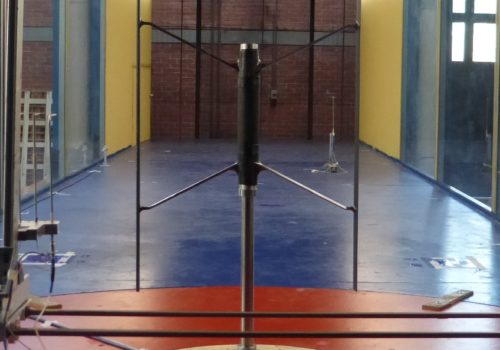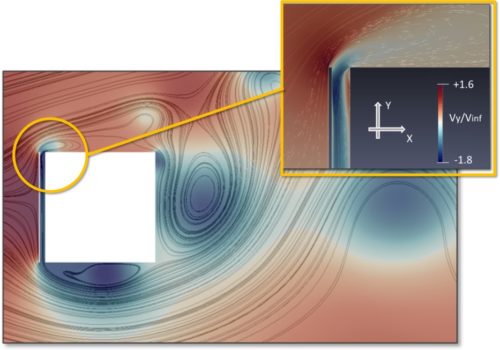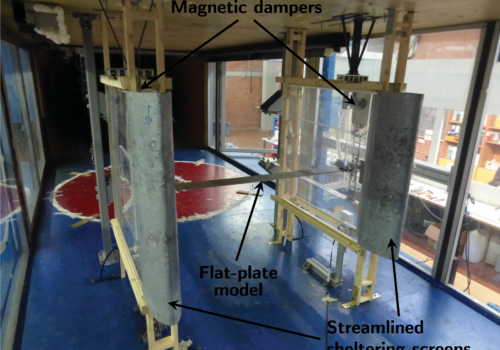UNSTEADY GALLOPING OF LOW SIDE-RATIO RECTANGLES
Research activity duration: 2012 – now
Rectangular cylinders of low side-ratio are very important in flow-induced vibrations (FIV) of bluff bodies, not only because they represent, sometimes in a clean schematic fashion, various kinds of existing structures or structural elements, but also because, depending on the side-ratio, they are prone to different types of aeroelastic instabilities. Such slender prismatic and nearly-prismatic bodies, characterized by a bluff cross section with sufficient afterbody, are prone to both vortex-induced vibration (VIV) and galloping. Galloping instability in the transverse degree of freedom usually occurs at high reduced flow speed and is therefore approached with the quasi-steady theory. By contrast, vortex-induced vibration is a low-reduced flow-speed phenomenon. Nevertheless, if the oscillating structure is light and low-damped, i.e. the dissipation capability of the system is low, three important consequences can ensue: (i) vortex-induced vibrations may occur with large amplitudes in a wide range of flow speeds; (ii) the onset of VIV and galloping may be expected at close flow speeds and the two phenomena may interfere with each other; (iii) the quasi-steady theory could fail to predict the galloping instability threshold and the post-critical oscillatory behaviour, due to the insufficiently high reduced flow speed. In this last case, quasi-steady theory does not apply and therefore one may refer to this form of instability as unsteady galloping.
The interest in this issue directly descended from an experimental campaign conducted in order to assess the structural safety of a two long-span steel arch structures recently built in Milan, Italy, for Expo 2015 World Fair. The structures have only aesthetic purposes and are therefore very flexible and light, which makes them sensitive to wind-induced excitation and prone to aeroelastic instabilities.
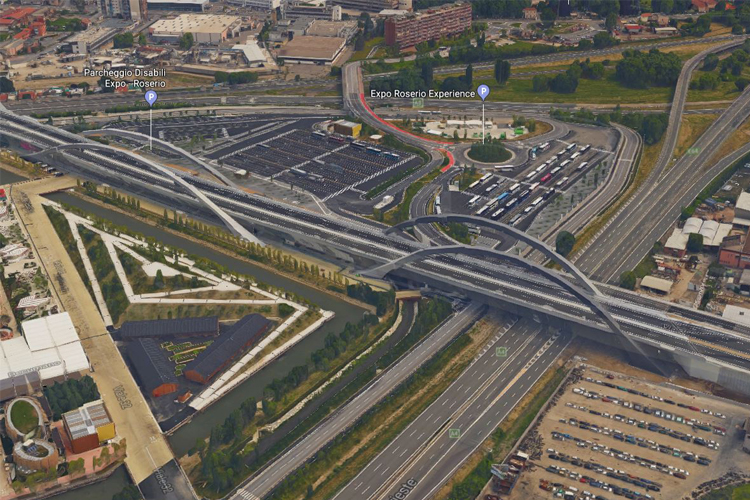
View of the arch structures in Milan (Google Maps).
During the last five years this phenomenon has been approached with a renewed interest by our research group, after the first pioneering studies conducted between the Sixties and the Seventies. Different aspects related to the same problem were studied someway separately, answering time by time to some lacks of knowledge evidenced through literature review or laboratory tests.
At first, a deep literature review and the first experimental campaign was conducted (Mannini et al. 2014), underlying the need to improve the setup to properly and arbitrarily change the value of the crucial parameter represented by the Scruton number (mass-damping parameter). This has been done in Mannini et al. 2016a, by using a different dynamical setup employing eddy-currents damper devices for finely varying the mechanical damping ratio without affecting the frequency of the oscillating system.

Views of the dynamic setup in the wind tunnel: (left) detail of the elastic suspension system with plate-springs; (right) complete rig with the sheltering system.
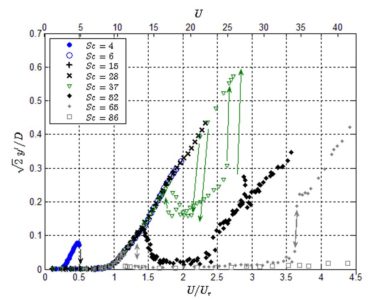
Summary of the amplitude–velocity curves for various Scruton numbers. The dashed line denotes the quasi-steady asymptotic trend for high reduced flow speeds, while the arrows highlight amplitude jumps and hysteresis loops. y’ is the standard deviation of the transverse oscillation time histories.
In addition, a small variation of the mean angle of attack of the rectangular cylinder (1°) and to a low- intensity free-stream turbulence (around 3%) was investigated. The behaviour does not change substantially in these cases but a light incoming turbulence seems to promote the interference between VIV and galloping for intermediate values of the Scruton number (around 40).
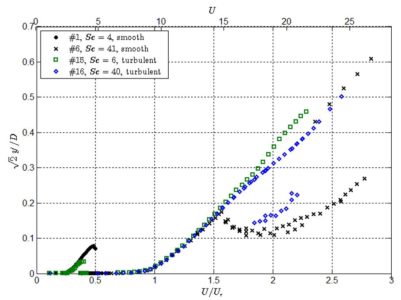
Comparison between amplitude–velocity curves obtained for smooth and turbulent flow.
An interesting join venture with Milan Polytechnic, reporting the extremely interesting comparison of laboratory results related to two different physical problems (one sectional and the other full-aeroelastic one), was conducted in Mannini et al. 2016b. In both experiences, a galloping-type instability starting at wind speeds close to the vortex-resonance velocity was observed in smooth flow, due to the interference of the mechanisms of vortex-induced vibration and ‘‘quasi-steady” galloping. Despite the differences in the facilities and in the models, a good agreement was found between the results obtained in the two laboratories. The major discrepancies concern the transitional behaviour for intermediate values of the Scruton number, the sectional model showing a more unstable behaviour.
A more detailed study of unsteady galloping in turbulent flows was provided recently in Mannini et al. 2018a, testing a large variety of turbulence levels and performing accurate static measurements in turbulent flow (not so easy to find in literature). Not only the turbulence intensity level (IU) was varied but also the integral length scale employing different grid geometries with two different sectional models of different height but same side-ratio. The two models were also useful in assessing the existence of Reynolds effects in static measurements (apparently not present).

Static setup views with turbulence grid generator mounted close to the sectional model; two different sectional models are visible.
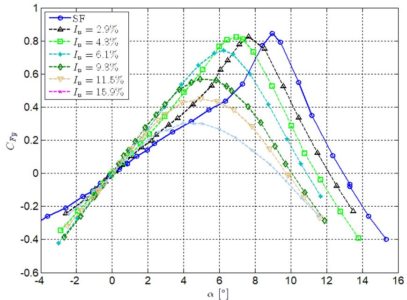
Static measurements of the lateral force coefficient by varying turbulence level.
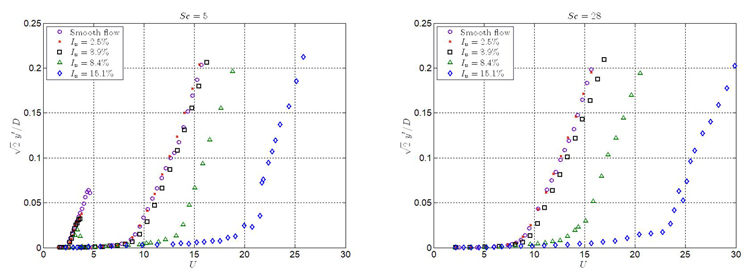
Amplitude-velocity curves for various turbulence intensities and Scruton numbers.
Last but not least, the dynamical behaviour experimentally observed has been tentatively approached using analytical models proposed by some Author in the past (Tamura and Shimada 1987), by slightly reformulating the coupled ODE system and better assessing and identifying some model parameter. The results are promising and proposed in Mannini et al 2018b.
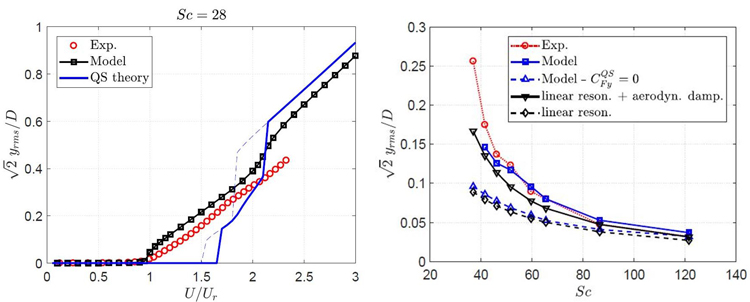
Amplitude-velocity curves comparison for a certain value of Scruton number of the proposed model (left), and Griffin plot of the whole simulations data-set (right).
An extension of the above mentioned experimental campaigns, carried out throughout the last six years, years is represented by water channel measurements, performed at FLAIR Water Channel (Monash University, Melbourne), conducted by Massai (2015a). For the same cross section (side ratio = body depth on width = B/D = 1.5) aerodynamic and hydroelastic experiments were performed, underlined a transitional dynamical behaviour from a very low Scruton number domain, implied by the different order of magnitude of the fluid density, to typical values of air-flows. The peculiarities and boundaries of this transition were addressed in the Ph.D. work, together with an estimation attempt of a crucial parameter present in the numerical model above cited. In addition, the afterbody and mass ratio effects (Massai et al. 2015b, 2016, 2018) and the angle of attack variation has been under investigation (and they still are).
For a complete understanding of such an articulated phenomenon, it is better to refer to the Bibliography proposed here below.
Bibliography
C. MANNINI, A.M.MARRA, G. BARTOLI (2014). Interference of vortex-induced vibration and transverse galloping for a rectangular cylinder. Journal of Wind Engineering and Industrial Aerodynamics, v. 132, p. 109-124.
C. MANNINI, A.M.MARRA, T. MASSAI, G. BARTOLI (2016a). Interference of vortex-induced vibration and transverse galloping for a rectangular cylinder. Journal of Fluids and Structures, v. 66, p. 403-423.
C. MANNINI, M. BELLOLI, A.M.MARRA, I. BAYATI, S. GIAPPINO, F. ROBUSTELLI, G. BARTOLI (2016b). Aeroelastic stability of two long-span arch structures: A collaborative experience in two wind tunnel facilities. Engineering Structures, v. 119, p. 252-263.
C. MANNINI, T. MASSAI, A.M. MARRA (2018a). Unsteady galloping of a rectangular cylinder in turbulent flow. Journal of Wind Engineering and Industrial Aerodynamics, v.173, pp. 210-226, Feb 2018.
C. MANNINI, T. MASSAI, A.M. MARRA (2018b). Modeling the interference of vortex-induced vibration and galloping for a slender rectangular prism. Journal of Sound and Vibrations (in press).
T. MASSAI (2015a). On the Interaction between vortex-induced vibrations and galloping in rectangular cylinders of low side-ratio. University of Florence – TU Braunschweig.
T. MASSAI T., J. ZHAO, D. LO JACONO, J. SHERIDAN (2015b). Mass ratio and afterbody effects in flow-induced vibrations of a 3:2 rectangular cylinder. Proceedings of the 14th International conference on Wind Engineering (ICWE14), 21-26 June 2015, Porto Alegre Brazil.
T. MASSAI, C. MANNINI, A.M.MARRA, G. BARTOLI (2016). Peculiar aspects of rectangular sections subjected to air and water flows. 14th Conference of the Italian Association for Wind Engineering (IN-VENTO14) 25-28 September 2016, Terni, Italy
T. MASSAI, J. ZHAO, D. LO JACONO, G. BARTOLI, J. SHERIDAN (2018). The effect of angle of attack on flow-induced vibration of low-side-ratio rectangular cylinders. Journal of Fluids and Structures, v.82, pp. 375-393, Aug 2018.

